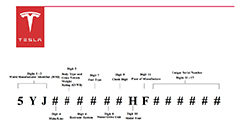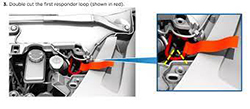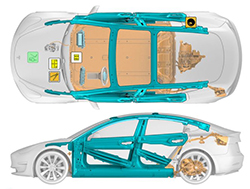
Standalone electric vehicles are nothing new to the LAFD. They have been around for decades. Their numbers were limited, though, and so was their exposure to field personnel. Fast forward to today where the number of electrical vehicles hitting the highway are starting to rival the traditional internal combustion models. One model in particular is increasing in popularity due to its affordability. That vehicle is the Tesla Model 3. According to Business Insider, Tesla is expected to make 10,000 Model 3s per week. Tesla has a multitude of models now in production, but this article will mainly focus on the Model 3 and how we, as first responders, can manage some of the hidden dangers that accompany its design in the case of an accident or fire. The following information was provided by Tesla Corporation for the exclusive use by first responders. Put it to good use and stay safe.
Identification of the Model 3


Model 3 can be identified by its Vehicle Identification Number (VIN). Locate the stamped plate on the top of the dashboard by looking through the driver’s side of the windshield. Model 3 is identified with a “3” in the fourth alphanumeric position.
Model 3 can also be identified by its Tesla badges and uniquely-shaped door handles. NOTE: Model 3 may have a “DUAL MOTOR” badge on the right-hand side of the trunk to indicate that it is a dual motor (all-wheel drive) configuration.
Model 3 can also be identified by its 15-inch (38 cm) touchscreen that is mounted in a landscape orientation.
Securing the Vehicle
CHOCK ALL WHEELS
The Model 3 moves silently, so never assume it is powered off. Drivers can choose a setting that determines whether or not their Model 3 will “creep” when a drive gear is selected. If this setting is off, Model 3 may not move unless the accelerator is pressed, even if shifted into Drive or Reverse. However, never assume that the Model 3 will not move. Always chock all four wheels.
SHIFT INTO PARK
Pressing the accelerator pedal even slightly can cause the Model 3 to accelerate quickly if the active gear is Drive or Reverse. To ensure that the parking brake is engaged, press the button on the end of the gear selector to shift into Park. Whenever a Model 3 is in Park, the parking brake is automatically engaged, and the touchscreen shows the active gear as Park (P).
FRONT TRUNK FIRST RESPONDER CUT LOOP


The first responder loop is a low voltage harness (located in the front trunk area). Cutting the first responder loop shuts down the high voltage system outside of the high voltage battery and disables the SRS and airbag components. When cutting the first responder loop, double cut it to remove an entire section. This prevents the wires from accidentally reconnecting. If the front trunk first responder cut loop is inaccessible, the rear pillar disconnect point (located under the trim panel next to the rear fixed glass) can also shut down the high voltage system outside of the high voltage battery and disable the SRS and airbag components in the same manner. Use a reciprocating saw or hydraulic rescue cutters to cut 6 inches (15 cm) through the rear pillar. After deactivation, the high voltage circuit requires two (2) minutes to de-energize. Warning: The supplemental restraint system (SRS) control unit has a backup power supply with a discharge time of approximately ten seconds. Do not touch the SRS control unit within 10 seconds of an airbag or pre-tensioner deployment.
REINFORCEMENTS AND ULTRA HIGH STRENGTH STEEL

The Model 3 is reinforced to protect occupants in a collision (Shown in Teal). Always use appropriate tools, such as a hydraulic cutter, and always wear appropriate PPE when cutting. Model 3 has areas that are defined as “no-cut zones” due to the presence of high voltage, gas struts, SRS components, or other hazards. Never cut or crush in these areas.
LIFT AREAS

Model 3 is equipped with a floor-mounted 400-volt lithium-ion high voltage battery. Never breach the high voltage battery when lifting from under the vehicle. When using rescue tools, pay special attention to ensure that you do not breach the floor pan. The high voltage battery is located under the floor pan. When lifting or stabilizing Model 3, only use the designated lift areas.
FIREFIGHTING
If you must extinguish a Model 3 involved in fire, use water and plenty of it. It can take approximately 3,000 gallons of water, applied directly to the battery, to fully extinguish and cool down a battery fire; always establish or request an additional water supply. If water is not immediately available, use dry chemicals, CO2, foam, or another typical fire-extinguishing agent to fight the fire until water is available. During overhaul, do not make contact with any high voltage components. Always use insulated tools for overhaul. Heat and flames can compromise airbag inflators, stored gas inflation cylinders, gas struts, and other components which can result in an unexpected explosion. Perform an adequate knock down before entering a hot zone. Battery fires can take up to 24 hours to extinguish. Consider allowing the battery to burn while protecting exposures. After all fire and smoke has visibly subsided, a thermal imaging camera can be used to actively measure the temperature of the high voltage battery and monitor the trend of heating or cooling. There must not be fire, smoke, or heating present in the high voltage battery for at least one hour before the vehicle can be released to second responders (such as law enforcement, vehicle transporters, etc.). The battery must be completely cooled before releasing the vehicle to second responders or otherwise leaving the incident. Always advise second responders that there is a risk of battery re-ignition. Due to potential re-ignition, a Model 3 that has been involved in a submersion, fire, or a collision that has compromised the high voltage battery should be stored in an open area at least 50 ft (15 m) from any exposure. A burning or heated battery releases toxic vapors. Responders should always protect themselves with full PPE, including a SCBA, and take appropriate measures to protect civilians downwind from the incident. Use fog streams or positive-pressure ventilation fans to direct smoke and vapors.
Conclusion
This is a brief overview on how to conduct yourselves when dealing with a compromised Tesla Model 3. As noted, there are many other hidden dangers not listed in this article. We highly recommend you refer to further available documentation online and fully familiarize yourself and your company with this vehicle. Be prepared-The future is here.
By John Hicks
Source: www.tesla.com
Tesla, Inc. was not involved in the development of this document and did not provide any input or otherwise edit, review or authorize it.
“Images and Trademarks Courtesy of Tesla, Inc. All Rights Reserved”


